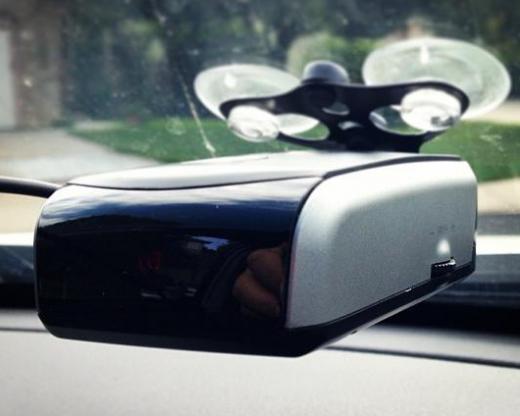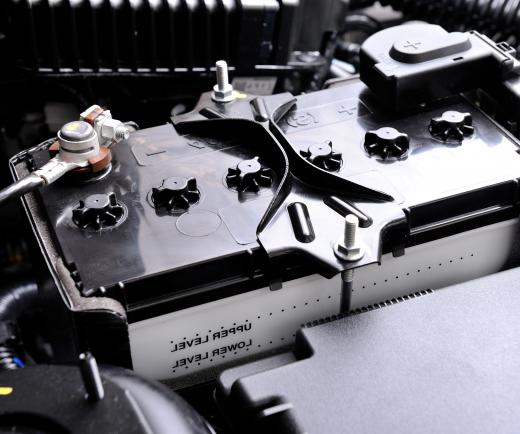A negative terminal is the grounded terminal on a car battery, typically marked by a minus (-) sign. It is usually color-coded black. The other terminal is positive, usually color-coded red or orange, and marked with a plus (+) sign. The grounded terminal connects to a grounded source on the vehicle, typically a bolt in the chassis. The positive terminal runs to the starter motor and to various switches, relays and accessories. If the battery is not grounded properly, the vehicle will not run.
Most vehicle batteries today are filled with a charged acid solution that expels gasses and is highly explosive. From time to time a battery might require distilled water be added to the fill-caps in order to keep the battery’s inner plates submerged in the acid bath. The solution should cover the plates, just reaching the fill-caps' bottom lip in each cell. Cells should have roughly the same level of acid.

It is very important to wear protective glasses and to avoid leaning over a battery when servicing it. If using a metal tool like a screwdriver to gently pry up the fill-cap covers, avoid touching either terminal, and do not lay tools on top of the battery. If the metal should touch both terminals at once, it could arc, creating sparks and a possible explosion.

When disconnecting a battery, remove the negative terminal (-) cable first, then the positive (+) cable. When connecting the battery, reverse these steps. Attach the positive terminal first, and the grounded or negative terminal last. Be careful attaching cables to terminal posts to avoid creating sparks.
It is a good idea to know how to jump start your car battery using another vehicle and jumper cables, should this ever become necessary. Connections should be made in a specific order, but first follow a few precautions. Line up the cars as close as possible without allowing them to touch. Engines should be off and both cars should be in park with headlights off. This procedure can cause a high-voltage spike that could potentially ruin electronics, so turn off all radios, radar detectors, CD players, GPS devices, and disconnect equipment from power outlets, such as cell chargers or power converters. Remove the cigarette lighter, if the car is so equipped.
Connect the first jumper cable clamp to the positive terminal (+) on the dead battery. Next, connect a clamp to the positive terminal (+) on the live battery. Connect a clamp to the negative terminal (-) of the good battery, and finally attach the last clamp to a ground on the chassis of the dead car. Use the same bolt that the car’s negative battery cable uses, if possible. Do not use greasy bolts or painted metal. It’s best to avoid using the negative terminal post because it will spark as the circuit is completed. To minimize any chance for explosions, using the chassis is recommended.
Once all connections have been made, start the good car and let it run a minute or so, revving it moderately. Try starting the dead car at this point. If the dead car’s motor is turning over but it won’t start, wait a couple more minutes while the good car continues running, then try again.
After the dead car starts, undo the jumper cables in reverse order. Both cars can continue running during this step, but as you are removing the jumper clamps take care that they do not touch anything or each other. Be aware of moving engine parts, including radiator fans and belts. Remove the jumper clamp from the chassis first, then from the negative terminal (-) on the good car. Next disconnect the jumper cables from the positive terminal (+) of the good battery, then from the positive terminal (+) of the previously dead battery.
Do not attempt to jump a battery that is leaking or is damaged. This could cause an explosion. A damaged battery should be replaced.
Battery terminals should be kept clean and free of acidic corrosion. Baking soda and water will neutralize and wash away corrosion, and Vaseline or a similar product can be used on clean terminals to prevent future corrosion.
A running vehicle in good mechanical condition will keep a healthy battery properly charged. A vehicle that sits for extended periods of time will drain the battery, and repeated re-charging will greatly shorten the battery’s life. To keep a new battery in tiptop shape, products like the BatteryMINDer® use A/C power to trickle charge the battery at a constant rate, turning off automatically to avoid overcharging. An alternative product is a solar panel charger, which typically sits on the dash and plugs into a live cigarette lighter or auto power outlet. A solar panel uses converted sunlight to maintain a healthy battery over extended periods of nonuse.
